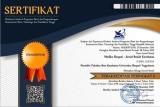ASUPAN ENERGI SEBAGAI FAKTOR DOMINAN KEJADIAN UNDERWEIGHT PADA BALITA DI KABUPATEN BOGOR
DOI:
https://doi.org/10.35842/mr.v16i3.512Keywords:
energy intake, toddler, underweightAbstract
Energy Intake as a Dominant Factor in the Incidence of Underweight Toddlers in Bogor Regency
Background: Being underweight is still a health problem for children under five in Indonesia. The direct factors that cause nutritional problems are food intake and infectious diseases. Objective: The prevalence of underweight among children aged 12-59 months in Bogor Regency is still relatively high. The purpose of this study was to prove energy intake as the dominant factor in the occurrence of underweight. Objectives: The prevalence of underweight among toddlers aged 12-59 months in Bogor is still high. The purpose of this study was to prove energy intake as a dominant factor in the occurrence of underweight. Methods: This research design is conducted using a cross sectional study design. This research is a quantitative study using secondary data from the 2019 Hibah PITTA B research from the Universitas Indonesia. The samples are 450 toddlers aged 12-59 months. The data analysis used chi-square test to determine the relationship between independent and dependent variables. Multivariate analysis also conducted by using multiple logistic regression tests to determine the factors that contribute to the incidence of underweight in children under five. Results: The prevalence of underweight in children under five in Babakan Madang Sub-District in 2019 was 23.1%. The results of multivariable logistic regression analysis found that energy intake was the only significant predictor of the incidence of underweight children aged 12-59 months. Toddlers with deficit energy intake had 1.92 times the risk of being underweight compared to toddlers with sufficient energy intake. Conclusion: Energy intake shown as the dominant factor in the incidence of underweight in children aged 12-59 months in Bogor. The prevalence of underweight contributes to lost productivity, as well as high morbidity and mortality rates. Multisectoral collaboration is very important in implementing intervention strategies to prevent underweight in children under five based on the problem of toddler food intake and other contributing factors.
References
Badan Penelitian dan Pengembangan Kesehatan. (2018). Laporan Riset Kesehatan Dasar Nasional Tahun 2018. Badan Penelitian Dan Pengembangan Kesehatan, p. 198. Retrieved from http://labdata.litbang.kemkes.go.id/images/download/laporan/RKD/2018/Laporan_Nasional_RKD2018_FINAL.pdf
Badan Penelitian dan Pengembangan Kesehatan. (2019). Laporan Riset Kesehatan Dasar Provinsi Jawa Barat Tahun 2018. In Lembaga Penerbit Badan Penelitian dan Pengembangan Kesehatan.
Bahjuri, P., Ardhiantie, Arifi, M. dzulfikar, Trisnantoro, L., Handono, D., Kurniawan, M. F., … Nirmalasari, E. (2017). Modul Sinkronisasi RPJMD-RPJMN Bidang Kesehatan dan Gizi Masyarakat. 129.
Brander, R. L., Pavlinac, P. B., Walson, J. L., John-Stewart, G. C., Weaver, M. R., Faruque, A. S. G., Kotloff, K. L. (2019). Determinants of linear growth faltering among children with moderate-to-severe diarrhea in the Global Enteric Multicenter Study. BMC Medicine, 17(1), 214. https://doi.org/10.1186/s12916-019-1441-3
Ernawati, F., Prihatini, M., & Yuriestia, A. (2016). Gambaran Konsumsi Protein Nabati Dan Hewani Pada Anak Balita Stunting Dan Gizi Kurang Di Indonesia (The Profile of Vegetable - Animal Protein Consumption of Stunting and Underweight Children Under Five Years Old in Indonesia). Nutrition and Food Research, 39(2), 95–102. https://doi.org/10.22435/pgm.v39i2.6973.
Firman, A. N., & Mahmudiono, T. (2018). Kurangnya Asupan Energi dan Lemak yang Berhubungan dengan Status Gizi Kurang pada Balita Usia 25-60 Bulan. The Indonesian Journal of Public Health, 13(1), 48–58.
Heryani, E. (2021). The Effect of Nutrition Food Diversity Assistance on Weight Gain of Undernourished Toddlers at Jambi City. First International Conference on Health, Social Sciences and Technology (ICOHSST 2020), 278–281. Atlantis Press.
Joseph, S. A., CasapÃa, M., Blouin, B., Maheu-Giroux, M., Rahme, E., & Gyorkos, T. W. (2014). Risk factors associated with malnutrition in one-year-old children living in the Peruvian Amazon. PLoS Neglected Tropical Diseases, 8(12), e3369–e3369. https://doi.org/10.1371/journal.pntd.0003369
Kartasapoetra, G., & Marsetyo, H. (2008). Ilmu gizi: Korelasi gizi, kesehatan, dan produktivitas kerja.
Kementrian Kesehatan RI. (2020). Indikator Program Kesehatan Masyarakat Dalam RPJMN dan Renstra Kementerian Kesehatan Tahun 2020-2024. Kemenkes RI.
Khamis, A. G., Mwanri, A. W., Ntwenya, J. E., & Kreppel, K. (2019). The influence of dietary diversity on the nutritional status of children between 6 and 23 months of age in Tanzania. BMC Pediatrics, 19(1). https://doi.org/10.1186/s12887-019-1897-5
Lestari, N. D. (2016). Analisis Determinan Gizi Kurang pada Balita di Kulon Progo. Yogyakarta, 1(1), 15–21.
Moursi, M. M., Arimond, M., Dewey, K. G., Trè, S., Ruel, M. T., & Delpeuch, F. (2008). The Journal of Nutrition Community and International Nutrition Dietary Diversity Is a Good Predictor of the Micronutrient Density of the Diet of 6-to 23-Month-Old Children in Madagascar 1-3. J. Nutr, 138, 2448–2453. https://doi.org/10.3945/jn.108.093971
Muhoozi, G. K. M., Atukunda, P., Mwadime, R., Iversen, O., & Westerberg, A. C. (2016). Nutritional and developmental status among 6-to 8-month-old children in southwestern Uganda: a cross-sectional study. https://doi.org/10.3402/fnr.v60.30270
Pratiwi, R. H., Suyatno, S., & Aruben, R. (2015). Faktor-faktor yang berhubungan dengan berat-kurang (underweight) pada balita di perkotaan dan perdesaan Indonesia berdasarkan data Riskesdas tahun 2013. Jurnal Kesehatan Masyarakat (e-Journal), 3(2), 127–137.
Rahim, F. K. (2014). Faktor risiko underweight balita umur 7-59 bulan. KEMAS: Jurnal Kesehatan Masyarakat, 9(2), 115–121.
RodrÃguez, L., Cervantes, E., & Ortiz, R. (2011). Malnutrition and gastrointestinal and respiratory infections in children: a public health problem. International Journal of Environmental Research and Public Health, 8(4), 1174–1205.
Scaglioni, S., Arrizza, C., Vecchi, F., & Tedeschi, S. (2011). Determinants of children’s eating behavior. The American Journal of Clinical Nutrition, 94(suppl_6), 2006S-2011S.
Utami, N. W., & Rahmawati, D. (2020). Frekuensi Makan, Asupan Energi Dan Protein Terhadap Status Gizi Pada Balita Di Puskesmas Minggir Sleman. INVOLUSI: Jurnal Ilmu Kebidanan, 10(2), 56–61.
Yunitasari, A. R., Sartika, R. A. D., Setiarini, A., & Irwan, R. B. (2020). Household Factors Associated with Underweight in Children 24-59 Month in Urban and Rural in Indonesia. 16(1), 140–151.




